2nd Japan Construction International Award
Construction Project Category
- The Project for the Rehabilitation of Kurgan Tyube-Dusti Road (Phase I and II )(Tajikistan)
- Singapore Changi Airport Terminal 4 New Construction (Singapore)
- SORA gardens I (Vietnam)
- Noibai International Airport 2nd Passenger Terminal (Vietnam)
- The Project for Safe Water Supply and Improvement of Hygiene Conditions in Rural Areas (Senegal)
The Project for the Rehabilitation of Kurgan Tyube-Dusti Road (Phase I and II )(Tajikistan)
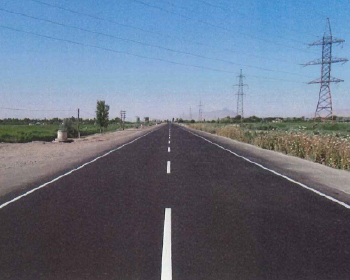
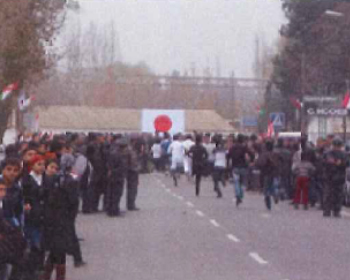
Project overview
- Construction including improvements to the national highway (42km section (phase I) and 17.9km section (phase II)) connecting Dushanbe, the capital of Tajikistan, with the Afghan border, which is part of the Asian Highway Initiative and also serves as a major international road, such as bridge renovations and intersection improvements and more.
- Ensuring stable transportation of people and goods within the region contributed to regional development, correction of regional disparities, secure access to education and medical facilities, and an increase in the number of employment opportunities.
Data
Period: From May 2009 to June 2013
Procuring Entity: Ministry of Transport, Republic of Tajikistan
Applicant: DAI NIPPON CONSTRUCTION
Relevant Companies
Design: INGÉROSEC Corporation (Phase I ), Katahira & Engineers International (Phase II )
Construction: DAI NIPPON CONSTRUCTION – NIPPO JV (Phase I ), DAI NIPPON CONSTRUCTION (Phase II )
Evaluation points
- A relationship of trust was built through the project due to determination to complete the project and confidence that the Republic of Tajikistan and Japan would work together to construct a high-quality road. Following completion of construction, events such as a marathon in which the Japanese flag was displayed at both the start and finish lines greatly contributed to developing friendly relations between the two countries.
- Although construction skills were scarce, it was possible to steadily transfer skills and achieve a four-month shortening of the construction period by hiring local workers long-term and carrying out construction under a direct management system that directly provided workers hired on-site with instructions and guidance.
- In addition to preventing the occurrence of traffic accidents by stationing traffic controllers to provide smooth traffic guidance, not establishing detours contributed to maintain the environments surrounding construction sites and ensured agricultural production.
- It was recognized locally as a landmark project executed by Japan, as evidenced by the president of Tajikistan attending the completion ceremony, among other things.
Singapore Changi Airport Terminal 4 New Construction (Singapore)
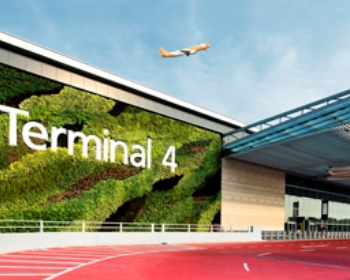
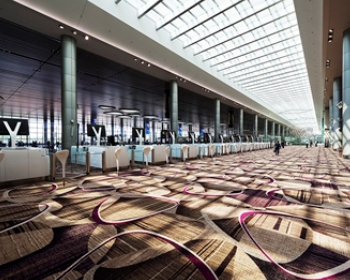
Project overview
- Construction of a new international terminal at Singapore Changi Airport, one of Asia’s leading hub airports.
- High-level digitization (automatization including ticketing, immigration inspections, boarding procedures, etc. linked with facial recognition systems) reduced the need for personnel and labor.
- The transit area functions as a commercial space for those passing through the airport due to transfers.
- The interior was designed as a lush atrium using natural light pouring in through large skylights, open spaces, all-surface glass curtain walls, as well as a broad range of plants and green walls.
Data
Period: February 2014 to March 2017
Procuring Entity: Changi Airport Group (CAG)
Applicant: Takenaka Corporation
Relevant Companies
Design Development & Construction: Takenaka Corporation
Architecture Qualified Person: SAA Architects
Concept Design: Benoy
Evaluation points
- Having connection since the opening of Changi Airport Terminal 1 in 1981, the company has continued to be involved in maintenance and renovation of the airport along with development of Singapore, and in the large-scale Terminal 4, the company successfully created a verdant, state-of-the-art airport environment. The client praised the company saying, “Takenaka Corporation provided a superlative and comprehensive proposal, including even innovative construction methods.”
- Proper governance was achieved with integrity and transparency based on Design and Construction Contracts with the local Real Estate Developer’s Association, and local authorities highly praised the work for its quality and economic efficiency during operation.
- A significant number of local jobs were created, including more than 1,000 staff member positions and more than 4,000 workers who engaged in the project from Takenaka Corporation and more than 400 partner companies both inside and outside of Singapore.
- Social and environmental consideration was made by adopting design in accordance with universal design guidelines, proper routing of construction vehicles to prevent traffic congestion and accidents, implementing idling stop policy and energy efficiency by reducing personnel.
SORA gardens I (Vietnam)
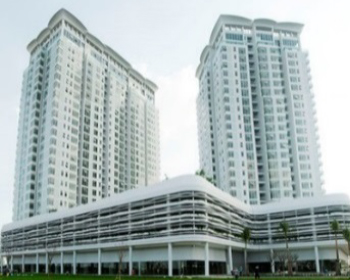
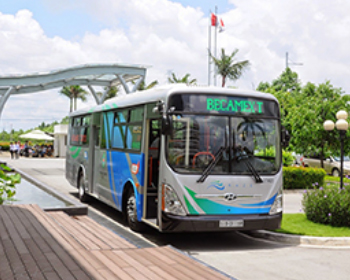
Project overview
- The first property in “Binh Duong New City,” located about 30km north from central Ho Chi Minh City, Vietnam’s economic center. Condominium construction with Japanese quality.
- TOKYU CORPORATION established a joint venture (BECAMEX TOKYU) with BECAMEX IDC, a local developer, to promote urban development in close relation with local authorities.
- In order to realize public transport-oriented development (TOD), BECAMEX TOKYU BUS Co., LTD (100% owned by BECAMEX TOKYU Co., LTD), established in cooperation with TOKYU BUS, also operates bus routes linking the new city and to the old town.
Data
Period: November 2012 to March 2015
Procuring Entity: BECAMEX TOKYU Co., LTD
Applicant: BECAMEX TOKYU Co., LTD
Relevant Companies
Design: PTW Architects
Construction: Hoa Binh Corporation
Construction Supervising Consultant: Meinhardt
Accounting Consultant: Apave
Evaluation points
- This project was highly praised locally not only for the Japanese-style design, specifications and on-site management of the building but also for its post-development management and commercial facilities, and the project became the foundation for TOD development in Binh Duong New City.
- Instead of real estate development that is “hands-off once construction is completed,” TOKYU CORPORATION implemented Japanese-style urban development that fully leveraged TOD know-how cultivated in Japan, including development and operation of commercial facilities and events to revitalize local communities.
- The company provided high-quality real estate that fits in well with the local climate and culture but that also feels “Japanese” through reducing life cycle costs in the hot, humid environment by using highly-viscous paints, which rarely crack or stain, and incorporating Japanese elements based on the concept of “Japan Quality” with an understanding of Vietnamese preferences.
- Transfer of skills and comprehensive quality control were achieved by dispatching experienced Japanese contractors to instruct local designers and construction managers via OJT.
Noibai International Airport 2nd Passenger Terminal (Vietnam)
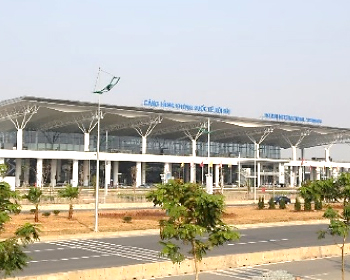
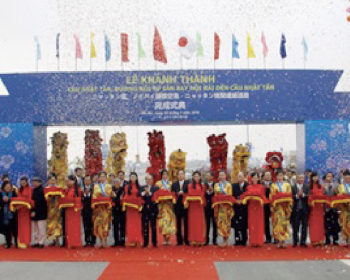
Project overview
- Construction of new terminal at Noi Bai International Airport, which continues to experience a rapid increase in its annual number of users.
- A bulk order was received for the entire airport facility, including construction of a passenger terminal building, civil works such as viaducts, special airport equipment and a fuel provision system.
- Responding to the needs of the client, who desired an early opening, the project was completed three months ahead of schedule and immediate opening after hand-over was ensured through trial operation of the airport within the construction period in close communication with airport operators.
Data
Period: February 2012 to December 2014
Procuring entity: Airports Corporation of Vietnam (ACV)
Applicant: TAISEI CORPORATION
Relevant Companies
Construction Management: Japan Airport Consultants, Inc.
Construction: TAISEI CORPORATION and VINACONEX JV
Project Management: Japan Airport Consultants, Inc.
Evaluation points
- This project demonstrated Taisei Corporation’s technological capabilities and airport construction know-how, and it achieved “early completion and immediate opening after hand-over.”
- Introducing “hydrant-type refueling equipment”, which provides fuel from a storage tank through underground pipes, for the first time in Vietnam, technological transfer regarding its usage was made. Efficient operation of the airport was promoted through such provision of know-hows for operation.
- Utilizing a “Global Human Resource System” constructed in-house, the company continuously employed 450 experienced in-house airport workers from ten countries around the world with a focus on Vietnamese engineers, and Japanese experts provided instruction on skills and know-how. Japanese-style safety management know-how was conveyed through “repeated training aimed at raising safety awareness.”
- The project paid great consideration to social and environmental matters, such waste reduction via thorough recycling, as well as surveys and confirmation of the status of preservation of the surrounding environment after completion. It was also highly praised internationally, including being selected by Skytrax as “the world’s most improved airport.”
The Project for Safe Water Supply and Improvement of Hygiene Conditions in Rural Areas (Senegal)
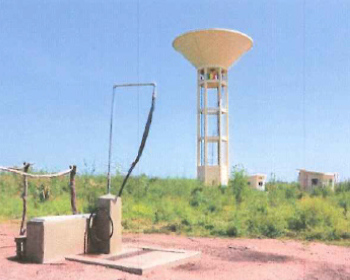
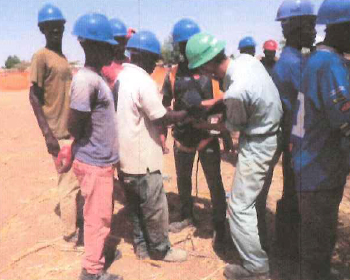
Project overview
- This project provided water supply facilities to use safe groundwater and sanitation facilities in rural areas in Senegal where basic infrastructure, such as electricity and water, was insufficient.
- New construction of water supply facilities, including deep well drilling, pumping facilities, long-distance gravity-based water supply pipes using elevated water tanks, and various types of water faucets for public use.
- Administrative officers and local residents were taught to perform light repairs, etc. with the aim of continuous maintenance. The project contributed to improving habits and sanitation in public restrooms and at handwashing locations installed in schools and medical facilities.
Data
Period: April 2016 to August 2017
Procuring Entity: Rural Well Bureau, Ministry of Water and Sanitation, Senegal
Applicant: NISSAKU CO., LTD.
Relevant Companies
Design: NIHON TECHNO CO., LTD.
Construction: NISSAKU CO., LTD.
Evaluation points
- Based on a relationship of trust with Senegalese clients and partner companies built up over the long period of time since the company first entered the region in 1979, the company achieved “quality infrastructure” by incorporating Japanese construction management, while also leveraging the construction capabilities of local partner companies. The project, which was aligned with the policy to integrate water supply and sanitation promoted by the Senegalese government, enabled provision of safe tap water while reducing the labor burden on women and children to fetch water. It was highly praised as a Japanese project, including being covered by a local television station.
- The project was particularly praised for reducing life cycle costs by using an auto-transfer ignition system in the submergible motor pumps and for employing local workers by specifically not using heavy machinery for simple, on-site tasks.
- Although Senegal presented risks that could not be assumed in Japan, proper process management was achieved by stationing Japanese technicians fulltime and through close communication between workers and local communities.